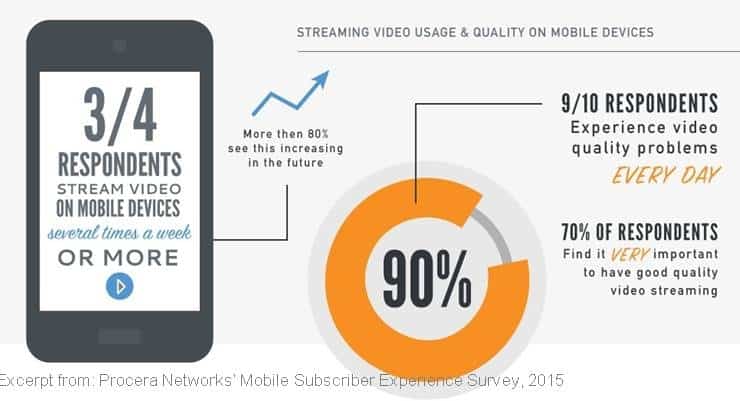Cisco's Global Mobile Data Traffic Forecast Update: 2014–2019 predicts that by 2019, mobile video will make up 72% of all traffic on mobile networks. By end of last year, mobile video was already taking up 55% of total traffic, and it is continuing to grow rapidly on the back of increased dependency on mobile devices such as smartphones and tablets for streaming video content especially short form videos (less than 10 minutes), that have started to become daily staples for a large number of mobile customers.
The trend towards video consumption on mobile devices does not come as a surprise - especially when more and more people have already shifted their media and entertainment consumption patterns to online sources - either to free, ad-sponsored video-on-demand (VoD) services or premium, subscription based VoD (SVoD). The former, popularized by the meteoric rise of video sharing platforms such as YouTube and Vimeo has onboarded millions of users to video content on-the-go, where short clips of news, music videos, comedies, documentaries, learning, advertisements and garden-variety home-made productions become constant companions for those with time to spend and bandwidth to spare. The popularity of free VoD went on to boost SVoD services, a boon for players such as Netflix, Vudu and Hulu and more recently, Sling TV, Amazon Prime and HBO Now who are betting on the Internet becoming the biggest source of video content globally in the next 5-10 years. Although research shows that most video content viewed on mobile is short-form and consumers reserve the viewing of longer content for later (on Wi-Fi or fixed broadband), both VoD and SVoD are becoming critical in pushing increased video consumption on mobile connectivity.
Mobile Operators, more specifically, are siding with the OTT players (strategy wise), taking the same bet that Internet content will eclipse other forms of video content consumed today - satellite TV, cable TV and IPTV - in providing the variety, relevancy and customization that is expected of content in coming years, specifically premium digital content. They are fast tracking their foray into the digital services space with video services being an immediate focus, and have started offering Mobile TV services as part of their suite of mobile multi-play. Tele2 Russia's Tele2 TV, Cellcom's Cellcom tv and a similar OTT TV service by T-Mobile Czech show how Mobile Operators are responding to the need and the ability of consumers to pay for mobile video content that has been curated and customized to the market's general viewing patterns.
Putting together these three major trends - (1) the mobile device being increasingly used as a streaming video device, (2) the popularity of online video content; and (3) Mobile Operators' own mobile video offerings - the customer's take on an Operator's service quality will now hinge on the customer's experience on streaming video. In other words, the overall customer satisfaction and hence, churn, spend and growth - will depend hugely on what goes on when the customer clicks on the 'play' button on his screen. If news snippets or movie trailers or engaging ads are buffered, stalled or worse still, throttled half-way to blurry moving images, and if these happen frequently, for example 2-3 times a week, the customers' take on the overall mobile service will be greatly impacted. This, coupled with the fact that video will continue making up the biggest chunk of traffic on mobile, and that video is the most accessed content on mobile, will mean that the single most important service benchmark for Mobile Operators will be the overall quality and experience on the delivery of mobile video.
Thomas Vasen,
Senior Director of Subscriber Experience Marketing,
Procera Networks

Insights into customers' expectations and their current experience on mobile video services were published recently in an article written by Thomas Vasen, the Senior Director of Subscriber Experience Marketing at Procera Networks, the global Subscriber Experience company. The article which shared results from Procera's Mobile Subscriber Experience Survey - summarized in the infographics (below) - showed that 75% of respondents stream video on mobile devices several times a week, with 80% expecting the trend to increase and 70% citing good quality as a very important aspect. Despite all these, however, the survey showed that 90% of customers experience video quality problems EVERYDAY.
The survey also highlighted the low likelihood of Mobile Operators learning about their customers' experience before it is too late. For example, the survey showed that 40% of customers only report issues to their Mobile Operators when they are very upset, and 45% said that they will never report their bad experience to customer service. At the same time, only 15% said they will actually call customer support and only 40% will use self-care apps to try to resolve their problems. Procera's Mobile Subscriber Experience Survey results were based on responses from 540 consumers from 62 countries, with 30% respondents coming from the U.S. and another 35% from Europe.
Given the above, Mobile Operators will be expected to shift their service quality and customer experience focus largely to the delivery of video on mobile, especially in regions which boast 4G LTE and LTE-A coverage, which creates an even higher expectation among subscribers that videos will stream faster, better and clearer. Mobile Operators need solutions that will help them to identify subscribers' experience levels on mobile video services in real-time, including being able to distinguish between issues which are within their control, such as network congestion, and which are outside, such as those originating from the content source. More importantly, Mobile Operators must be able to communicate to the end user when such issues arise, providing in real-time, mobile video performance matrix on user screens, which will go a long way in assuring customers that the Operator is aware of the issue and resolution is under way.





















